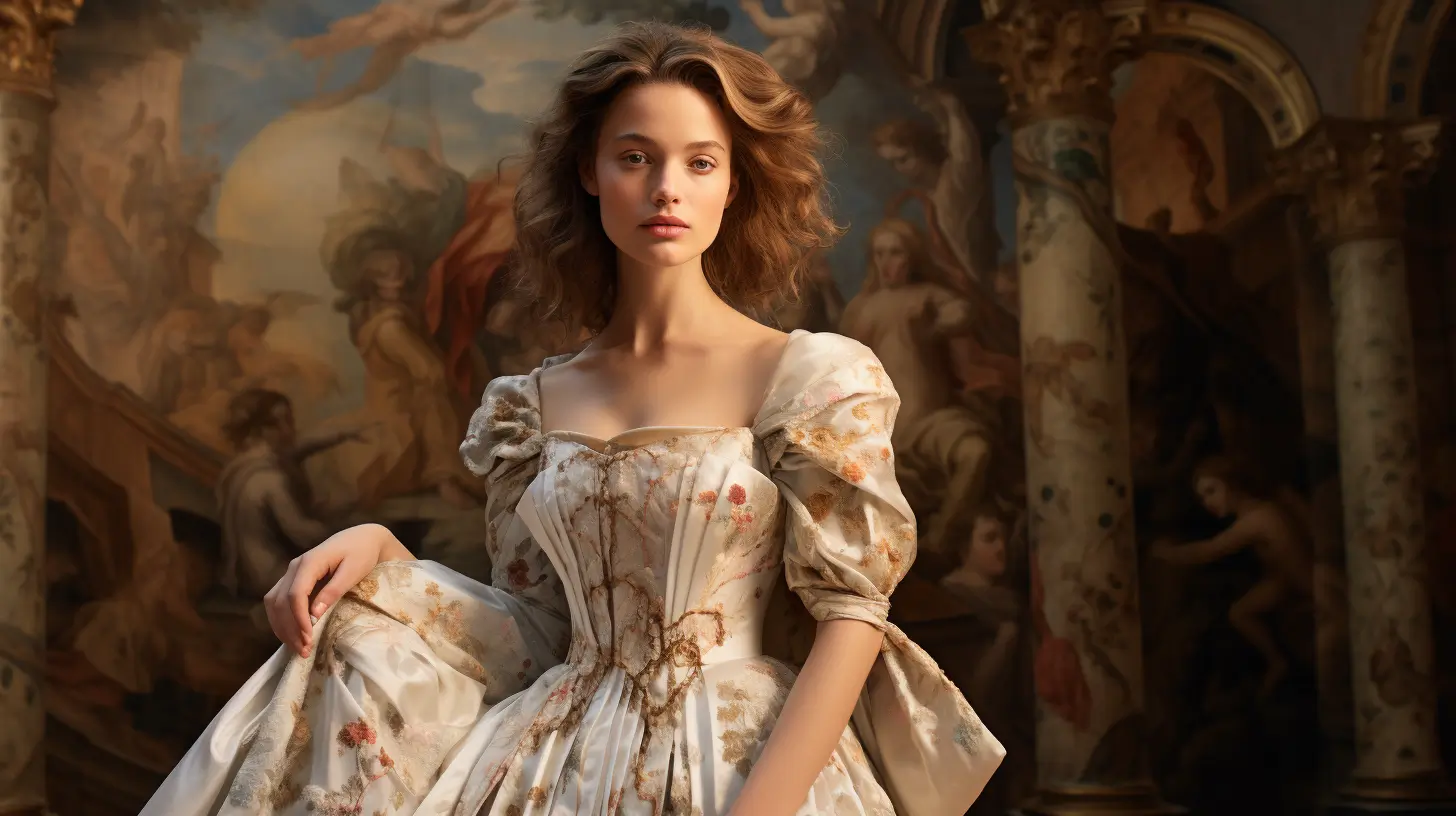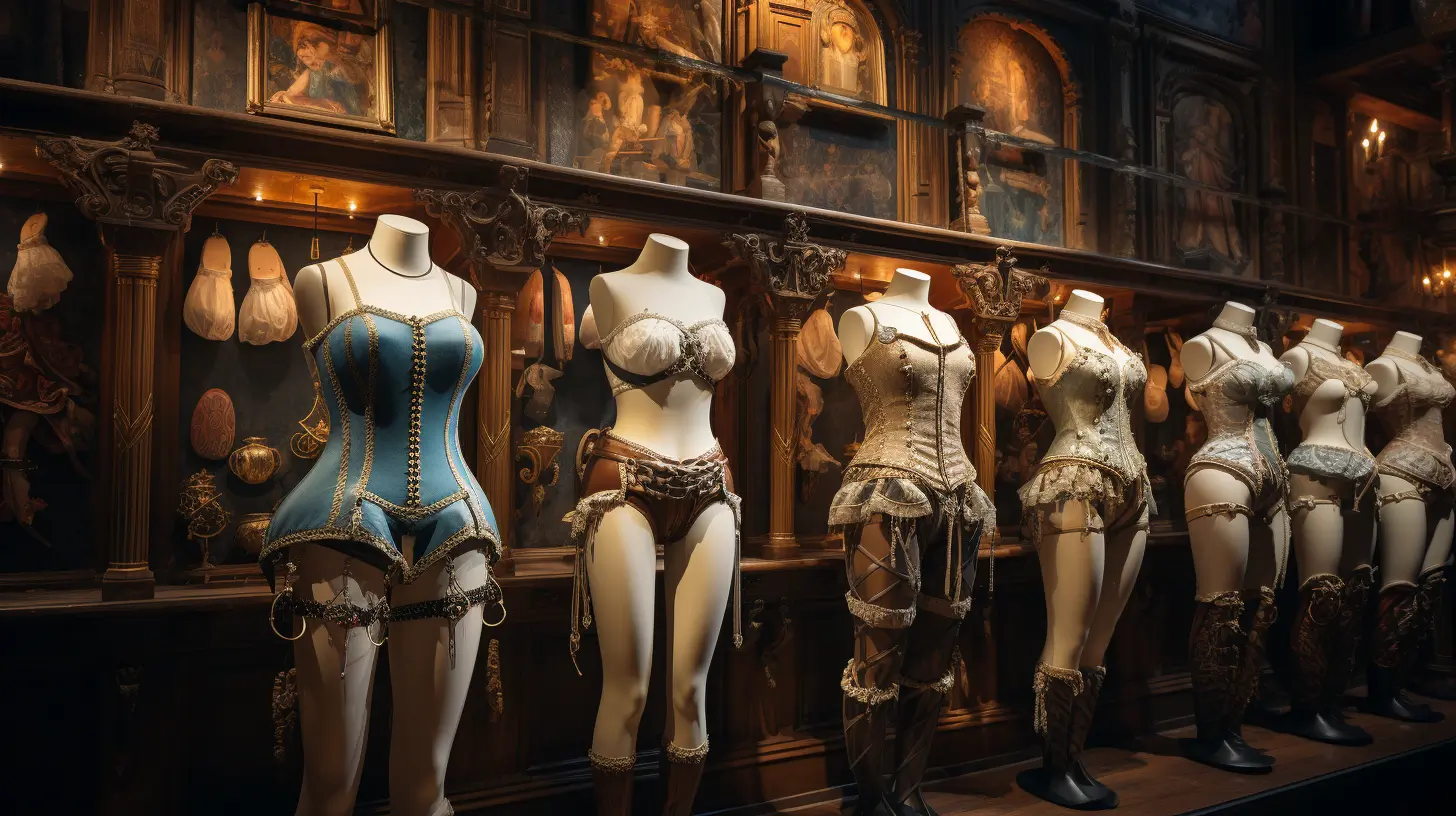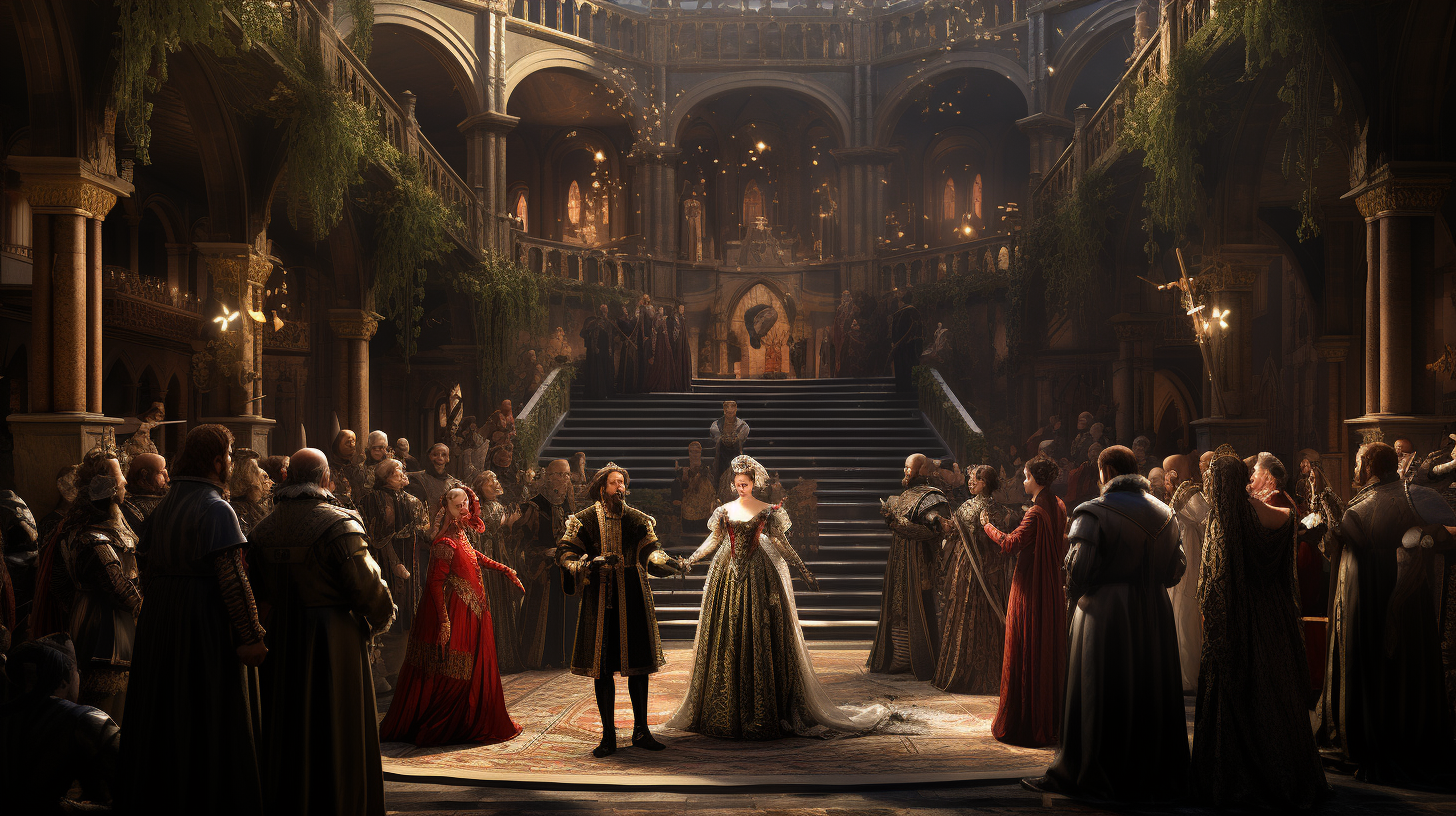
The Sharp Silhouettes of 1940s Mens Suits
A Stitch in Time: The Distinguished World of 1940s Men’s Suits
In the dance of decades, the 1940s Men’s Suits cut a figure that is both emblematic of its era and timeless in its appeal. This was a period draped in the gravity of global conflict, yet it was also a time when the fabric of society was richly patterned with cultural shifts and stylistic innovations. Imagine, if you will, a world where the silhouette of every man was a statement, a bold line drawn against the backdrop of wartime austerity and post-war hope.
The suit was the uniform of the day, but far from mundane. It was a marker of identity, a badge of resilience, and a canvas of personal expression. In the 1940s, every thread spun a narrative of necessity and luxury, weaving together the practicality of rationed fabrics with the extravagance of the zoot suit’s rebellious flair.
Let’s paint a picture here: You’re stepping onto the bustling streets of a 1940s city. The air is filled with the sound of big band jazz, the scent of fresh newsprint, and a palpable sense of transformation. Gentlemen pass by, each sporting suits that speak to their times – the broad shoulders and narrowed waist creating a V-shaped visage of strength; an aesthetic testament to the prevailing spirit of fortitude.
As we delve into the sartorial elegance of this storied decade, we won’t just recount the cut of the cloth or the line of a lapel. We’ll uncover the very essence of what made these garments more than mere attire but a cultural phenomenon. From the rationed wool to the excess of the zoot suit, we’ll explore how each thread and button reflected the zeitgeist of an era defined by its contrasts.
And for the visual among us, picture this image: A monochromatic scene, a crowded street corner where a dapper gentleman in a structured, double-breasted suit pauses, his silhouette sharply contrasting against the muted backdrop. The precision of the suit’s lines echoes the disciplined ethos of the time, while his confident stance suggests a narrative of personal assertion within the confines of societal expectations.
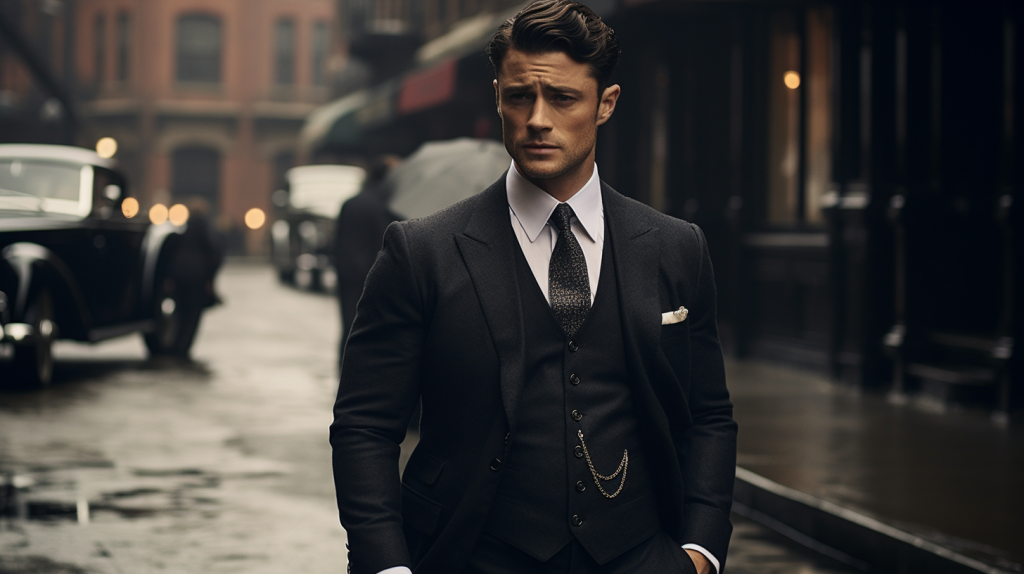
Tailoring in the Time of Ration Books: The Essence of 1940s Men’s Fashion
It’s like this – the 1940s, a decade that dressed to the nines within the confines of ration stamps and war-borne austerity. Fabric Rationing and its Impact, that was the tune of the times, with wool and silk being commandeered for military efforts. Men’s suits took a turn; they became a patchwork of ingenuity, a blend of practicality and innovation. Materials like rayon and synthetic fabrics made their mark as the front-runners of the period’s fashion staples. Picture a well-dressed gent, his suit sharp but sparing in its use of fabric, a testament to the era’s knack for making a little go a long way.
Now, let’s march on over to The Military Influence on Civilian Clothing. The war wasn’t just fought on the front lines but reflected in every stitch of the civilian’s daily wear. The military influence was unmistakable – just take a look at a man’s suit from that time. Notice the broad shoulders? The nipped-in waist? They’re echoing the uniform of soldiers, projecting an air of authority and preparedness that the times demanded.
Color me up with Colors and Patterns of the Decade. We weren’t just seeing greys and blues, no sir. There was a kaleidoscope of plaid and pinstripe, each pattern a subtle rebellion against the uniformity imposed by wartime. These patterns gave suits a personality, a sly nod to the individuality that men clung to.
And speaking of change, we can’t ignore the Transition from the ’30s: A Comparative Look. The ’40s suits, they didn’t just come out of thin air. They were an evolution, a sleeker and more utilitarian transformation from the looser fits of the ’30s. Less fabric, sure, but more definition. It was all about silhouette and making a statement with less.
Now, imagine this: a gallery of grayscale images, showcasing the stark shift from the wide-legged trousers of the ’30s to the more conservative, rationed suits of the ’40s. Each photograph captures the era’s unique blend of utility and style, a silent narrative of the fashion timeline.
The Devil’s in the Details: Design Nuances of 1940s Suits
You’ve got to understand, in the 1940s, every stitch counted, and every line spoke volumes. Now, let’s slice into The Cut: Single vs. Double Breasted. The single-breasted suit, with its sleek lines, was a daytime staple for the working man. On the flip side, the double-breasted suit, that was your power player, with its pronounced silhouette, it was the armor of the businessman and the evening socialite. It wasn’t just a style; it was a stance, a part of that post-war rebound of masculinity and confidence.
Moving up to the collarbone, we’ve got Signature Lapels: Widths and Styles. Picture this: a suit jacket, its lapel wide enough to land a plane on. We’re talking peak lapels, wide notched ones, commanding attention and framing the face with a sculptural precision that said, ‘I mean business’.
Now, drop your gaze to Trousers: Pleats and Cuffs. This was the era that walked the fine line between form and function. Pleated trousers allowed for movement and comfort, while cuffs added weight to the hem, offering a drape that spoke of understated elegance.
And can we talk about Pocket Placement and Styles? Flap pockets, jetted pockets – they weren’t just about holding a handkerchief or a couple of coins. They were part of the suit’s geometry, placed to accentuate the body’s lines, to draw the eye here or there, to add a bit of practical flair to the day’s necessities.
Envision a scene – a tailor’s atelier with suits in various stages of completion, the air heavy with the sound of shears cutting through fabric. The walls adorned with sketches of suit designs, each detail annotated for the master’s attention. This image would speak volumes about the craftsmanship and attention to detail that was poured into every garment of the decade.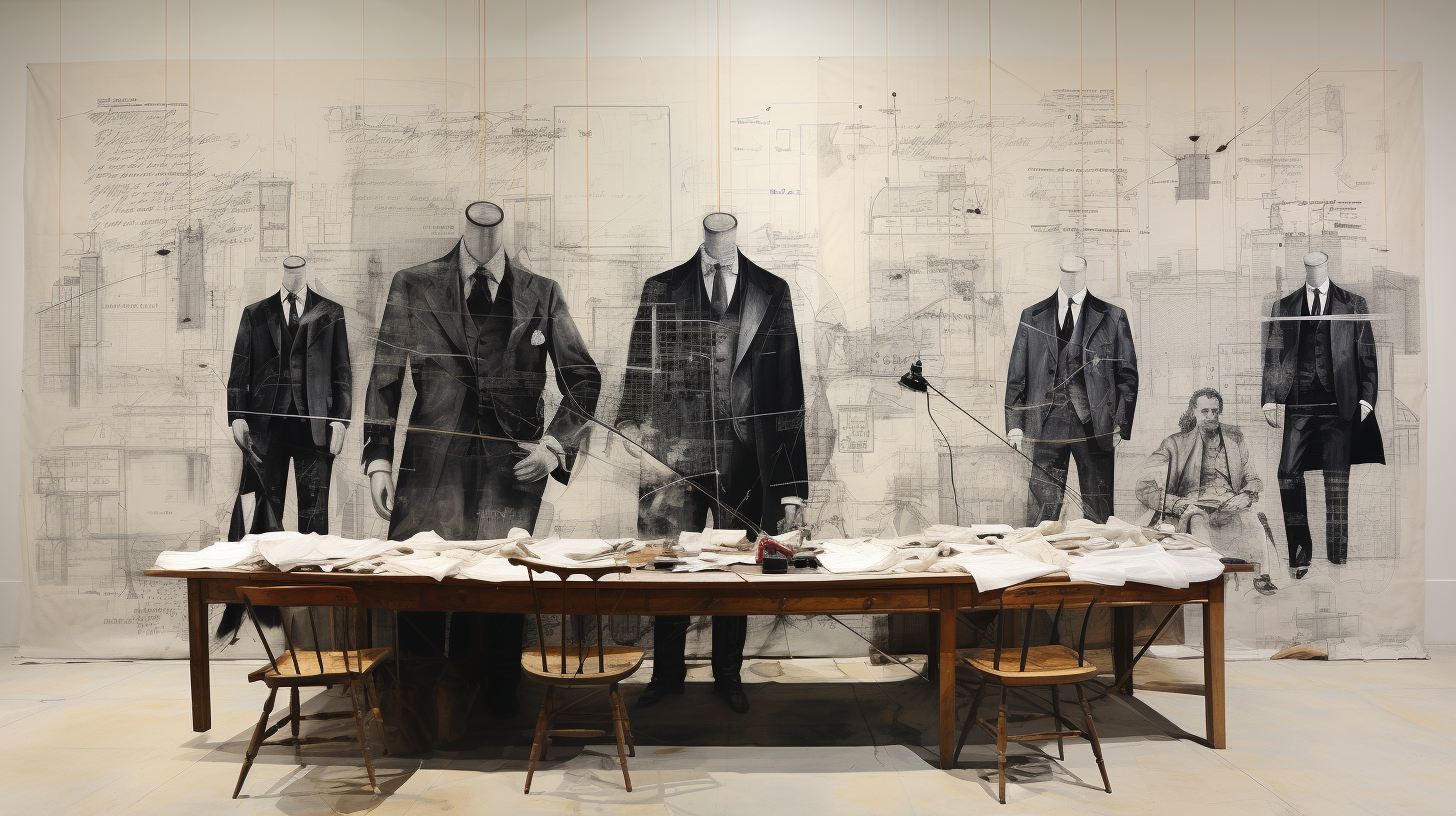
When Style Speaks Louder: Iconic Suits of the ’40s
The decade was a runway, and boy, did it have its icons. Let’s swing into The Zoot Suit: A Cultural Phenomenon. This wasn’t just fabric stitched together; it was rebellion sewn into seams, an oversized declaration of identity with a long coat, wide lapels, and trousers tight at the bottom. It said, ‘Here I am’, in a time when being seen and heard wasn’t granted to everyone.
Then there’s the tale of The Utility Suit: Function Meets Style. In an era of belts tightening, these suits were all about practicality, marrying the need for conservation with the desire for style. Imagine suits stripped of excess fabric, yet sharp, efficient – a sartorial nod to the nation’s collective effort.
Let’s roll out the red carpet for Hollywood’s Influence: Cinema and Celebrity Styles. The silver screen was the dream weaver, dictating what was in vogue. Hollywood had a knack for tailoring its stars in suits that walked straight off the screen and into the hearts of the adoring public. It was where fantasy met fabric.
Lastly, we dial the contrast between War-time vs. Post-war Suit Styles. Wartime was all about austerity, suits trimmed down by necessity. Then peace turned the page, and post-war styles breathed a sigh of relief. A little more fabric here, a little flair there – suits became a canvas of optimism, reflecting the world’s renewed spirit.
Picture a montage of these iconic suits: from the rebellious zoot suits in a smoky jazz club to the smart utility suits of the determined workforce; from the glamorous Hollywood styles dazzling under the spotlight to the evolving post-war suits, blossoming in newfound prosperity.
Unspun Tales: The Fabric of Fortitude in ’40s Fashion
We’re threading the needle to spotlight Rationed Resources: Wool and Synthetic Fabrics. Wool was worth its weight in gold in the ’40s, commanding the scene with a presence that was both regal and required. Synthetics were not just in vogue by choice, but by necessity, stepping into the breach where wool left a gap. Picture suits that had to stand the test of time and scarcity, cut from the cloth of innovation.
Moving on to Durability and Quality in Wartime Clothing. Every stitch counted, every seam a soldier in the battle of longevity. This was a time when a suit wasn’t just a garment but a companion through years of challenge. The quality had to withstand the wear and tear of a world in turmoil – a true testament to the era’s resilience.
Let’s zoom in on the Linings and Trimmings: A Closer Look. The devil was in the details, they said, and in the ’40s, the linings and trimmings were a silent rebellion against the austere exterior. Silken linings whispered luxury against the skin, a secret embrace. Trimmings were the subtle trademarks of a tailor’s defiance against uniformity.
Finally, we’ll uncover the Innovations in Fabric Due to War Efforts. Necessity is the mother of invention, and war spurred innovation like no other. Fabrics became smarter, stronger, better suited for a world on the move. Suits were crafted not just to look sharp but to endure, borrowing pages from the book of military practicality.
Imagine a display, a collection of ’40s suits with swatches of wool and synthetic blends, the interiors turned out to show the luscious linings and trimmings. Each suit a story, each fabric a chapter of an era’s resourcefulness and ingenuity.
A Stitch in Time: The Craft Behind the Cuts
Let’s take a peek behind the curtain with The Art of Bespoke Suits. Bespoke tailoring was the backstage hero of the ’40s suit. It wasn’t just a process; it was a performance, with each measurement a note in a symphonic fit. The tailor’s chalk was the wand, and the fabric, an obedient muse, was transformed into suits that echoed the wearer’s silhouette.
Transitioning to the tale of Mass Production vs. Hand Tailoring. The era saw assembly lines battling time-honored traditions. Mass production became the norm, but hand tailoring? It was the signature on a masterpiece. This was a duel of efficiency against exclusivity, where the personal touch of hand tailoring still held its revered ground.
Now, let’s zoom in on the Detailing: Stitching and Construction. It’s the little things, the stitches unseen and the hidden reinforcements, that made ’40s suits not just garments but fortresses of fabric. Each buttonhole was a bastion, and the seams were stitched strongholds, fortifying men’s attire against the rigors of the day.
Lastly, let’s consider the Preservation of Suits: Then and Now. Preservation was paramount, as suits were not mere apparel but heirlooms. Mothballs were the guardians, and careful storage was the ritual. Today, we look back in awe at the suits that survived, marveling at their journey through time, preserving not just fabric but memories.
Visualize a gallery of tailored masterpieces, a tribute to the hands that crafted them. In the foreground, a bespoke suit, half-complete with pins and markings, as if the tailor stepped out for just a moment. In the background, ’40s suits on display, each with a story sewn into its seams.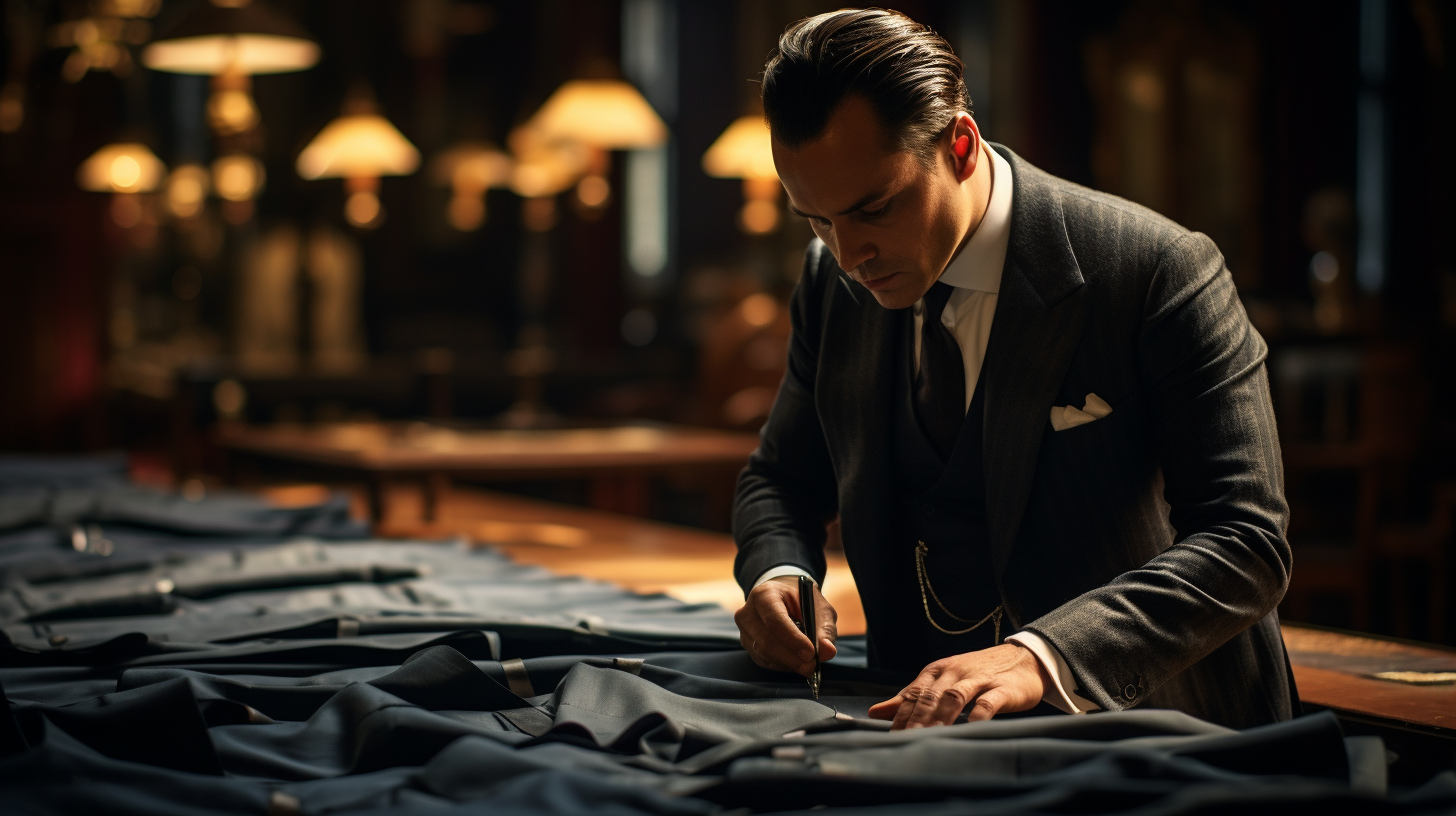
The Final Flourish: Accessorizing with Panache
Imagine stepping into a room where the Hats: Fedora, Trilby, and More are not just accessories but crowning glories of a gentleman’s attire. The fedoras, tilted just so, whispered of mystery, while the trilby hats spoke of a jaunty confidence. These were not mere head coverings; they were the exclamation points to the statement that was a man’s suit.
Now, let’s narrow the spotlight to Ties and Bowties: Patterns and Widths. The ties were as much a canvas of expression as any painting, with stripes, dots, and paisleys dancing along their lengths. The widths told their own tale—broad for boldness, slim for the slick—and bowties added a punctuation of sophistication.
Shifting our gaze to the Shoes: Styles that Completed the Look. Whether they were wingtips, loafers, or oxfords, each step in these shoes was a testament to the era’s craftsmanship. The shine on a man’s shoes reflected his pride, and the styles—oh, the styles—they were as varied as the men who wore them.
And finally, the Role of Cufflinks and Tie Clips. These were the silent understudies that held the show together. Cufflinks were the subtle wink of luxury on a man’s wrist, while tie clips were the silent anchors keeping ties in check. They might have been small, but their impact was mighty, ensuring a man’s polished look from head to toe.
Envision an image where these accessories come to life—a vintage-inspired illustration showcasing a collection of 1940s men’s hats in a classic lineup, ties and bowties draped elegantly with a vibrant display of patterns, and a selection of shiny leather shoes arranged in an inviting arc, with cufflinks and tie clips gleaming softly as they catch the light.
A Stitch in Time: Society’s Seam on Suit Styles
Let’s unfold the fabric of the era with the War Effect: Practicality in Design. As the world was in turmoil, suits were no exception to the influence of necessity and function. The designs became a reflection of the times—streamlined and devoid of excess. They were more than garments; they were a canvas where the narrative of resilience and resourcefulness was embroidered in every stitch.
Turning the pages of history to the Rebellion in Style: The Zoot Suit Riots, we touch upon a seam of cultural defiance. The zoot suit, with its broad shoulders and ballooned pants, became a symbol of both flamboyance and protest. It wasn’t just an outfit; it was a statement against conformity, a bold stride in the social fabric that led to one of the most sartorially centered social upheavals.
In the realm of Class and Society: Accessibility of Suits, we see how the suit became a democratic expression of style. No longer confined to the upper echelons, quality tailoring became accessible, allowing men from various backgrounds to don the mark of respectability. Suits blurred the lines of class, stitching together a society where a man’s worth began to shift from his birthright to his suit’s cut.
Lastly, with Post-war Prosperity and Fashion Changes, the end of conflict brought a palette of change in men’s fashion. Prosperity saw the suit loosening its conservative ties, allowing for a resurgence of fabrics and colors. It was a time of renewal, where men’s suits not only regained their exuberance but also embraced the coming of a modern era.
Picture this: A visual tapestry that weaves together these societal threads—a collage where images of practical wartime suits contrast with the flamboyant zoot suits, interlaced with the egalitarian spread of middle-class suiting, and ending with the colorful array of post-war styles.
The Zoot Suit: Threads of Defiance
Swing into the narrative with the Origins and History of the zoot suit, a tale that zigs and zags through the corridors of fashion history. This wasn’t just a suit; it was a cultural concoction that percolated in the vibrant neighborhoods of Harlem, a garment that spun out to the jazz beats and the dance halls, becoming the banner of an era’s spirit.
In the folds of its exaggerated silhouette, the zoot suit wore its Symbolism and Sociopolitical Statements like a badge of honor. It wasn’t just wide-legged trousers and an oversized coat; it was a sartorial shout against the status quo. In an age of fabric rationing, the zoot suit declared its wearers’ refusal to cut down on individuality and flair.
Diving into the Zoot Suit Riots of 1943, we unravel a seam in history where fashion ignited flames of cultural clash. The zoot suit became the uniform of unrest, stitched with the threads of tension between a youth culture asserting their identity and a society clinging to rapidly changing norms.
Reflecting on the Legacy in Modern Fashion, the zoot suit’s spirit lives on, not just as a nostalgic nod to a bygone era but as a continued emblem of cultural pride and nonconformity. From runway revivals to the continued influence on streetwear, the zoot suit has tailored a permanent cut in the fabric of fashion history.
Visualize a snapshot: A sepia-toned collage depicting the evolution from the zoot suit’s heyday to its echoes in today’s fashion. A lone figure, draped in the iconic garb, stands defiant against a backdrop of historical and modern scenes—a timeless rebel.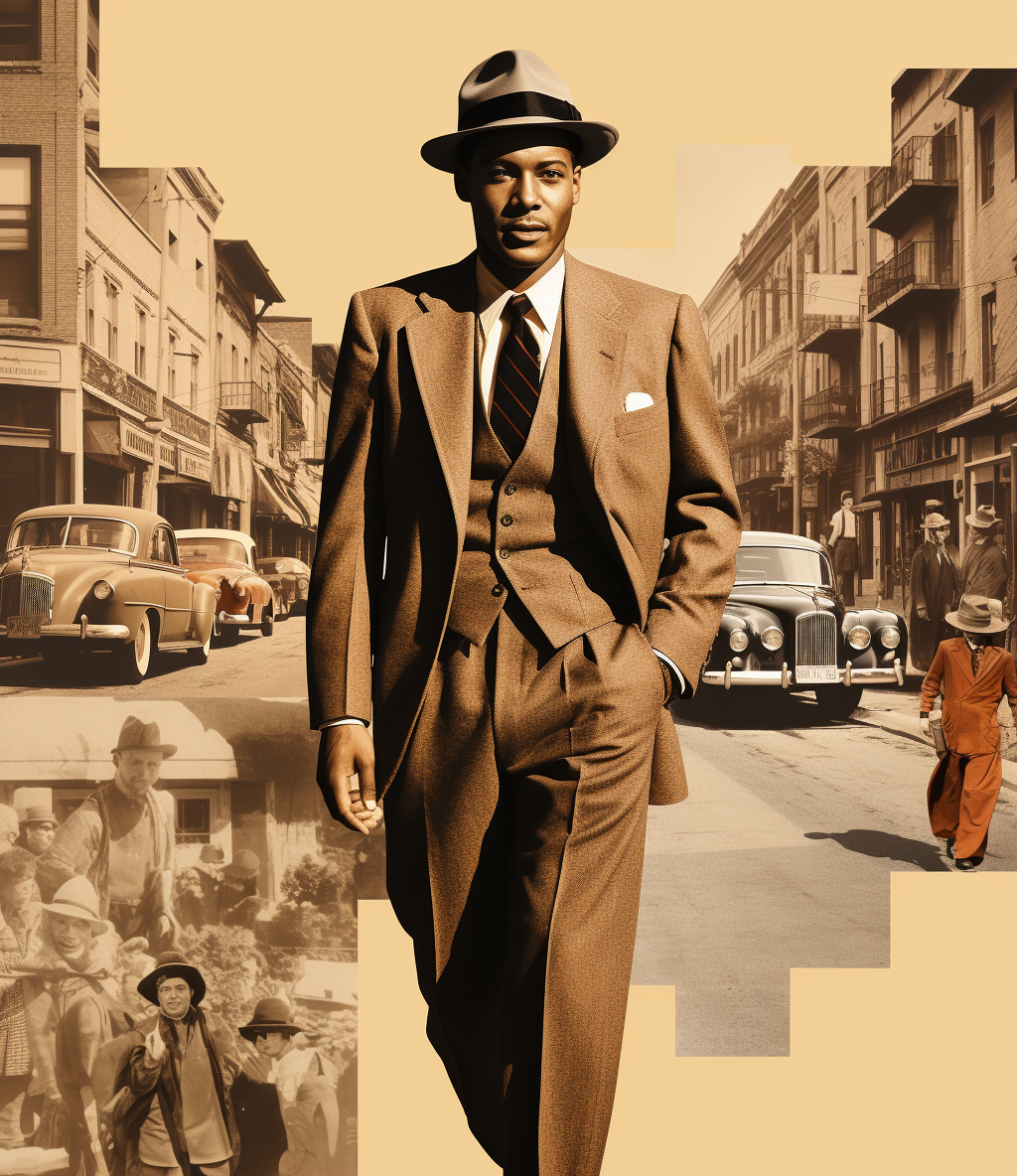
Echoes of Elegance: The 1940s Silhouette in Today’s Threads
Vintage Revivals: Runway and Street Style take a bow in the spotlight as we sashay through fashion’s cyclical dance floor. The 1940s menswear emerges from the fashion archives, not as relics but as timeless treasures, reborn on the runways and reclaimed by street style aficionados. It’s in the sharpness of a shoulder or the taper of a trouser where the old-school charm meets modern swagger.
When we scrutinize the Influence on Contemporary Suit Designs, it’s like glimpsing into a well-polished looking glass, reflecting a legacy that continues to shape the essence of menswear. The vintage virtue of the ’40s tailoring crafts a whispered narrative in the architecture of today’s suits, subtly cinching waists and straightening postures.
The silver screen, with its luminescent glow, pays perpetual homage through Cinematic Homages to the 1940s Aesthetic. Here, the decade’s style is not just costume but character, evoking the era’s gravitas and its genteel rebellion against adversity, frame by frame, in high definition.
And finally, the Resurgence in Vintage Collecting attests to the enduring allure of the ’40s suits. These garments are not mere articles of clothing but woven pieces of history, ardently sought by collectors who appreciate the narrative sewn into every stitch.
Imagine a tableau: A dapper model strides confidently down a contemporary city street, the sharp lines of a 1940s-inspired suit melding seamlessly with the pulse of the modern metropolis—a harmonious blend of past and present.
The Global Tapestry: Stitching Together 1940s Suit Styles
Embark on a sartorial expedition as we traverse the Atlantic and explore the distinctive British Tailoring during the 1940s. It’s a realm where tradition is woven into every thread, and where wartime restrictions couldn’t dampen the indomitable spirit of Savile Row’s craftsmanship. The British suit of the ’40s, though muted by necessity, still bore the mark of impeccable construction and understated elegance—a testament to resilience in the face of austerity.
Crossing over to the New World, The American Suit Silhouette charts a different course. There’s a sense of boldness here, a narrative of innovation and prosperity within the constraints of the times. It’s a style marked by broader shoulders and a freer waist, echoing a nation’s expansive spirit even during the war years.
Delving into the continent, we witness European Variations Post-war, where each country unfurls its distinct aesthetic post-conflict. Italian suits reclaim their flair, the French reinvigorate their haute couture, and throughout Europe, the suit becomes a canvas for cultural regeneration.
And lastly, the Influence of the 1940s on Global Fashion Trends is undeniably vast. From Tokyo to Buenos Aires, echoes of the era’s tailoring continue to reverberate. The ’40s set precedents in menswear that would ripple out to influence the shape of suits across the globe for decades to come.
Visualize a series of globes, each depicting a region of the world, with threads connecting them that highlight the 1940s’ influence on global fashion—threads that represent the enduring legacy of this pivotal decade in sartorial history.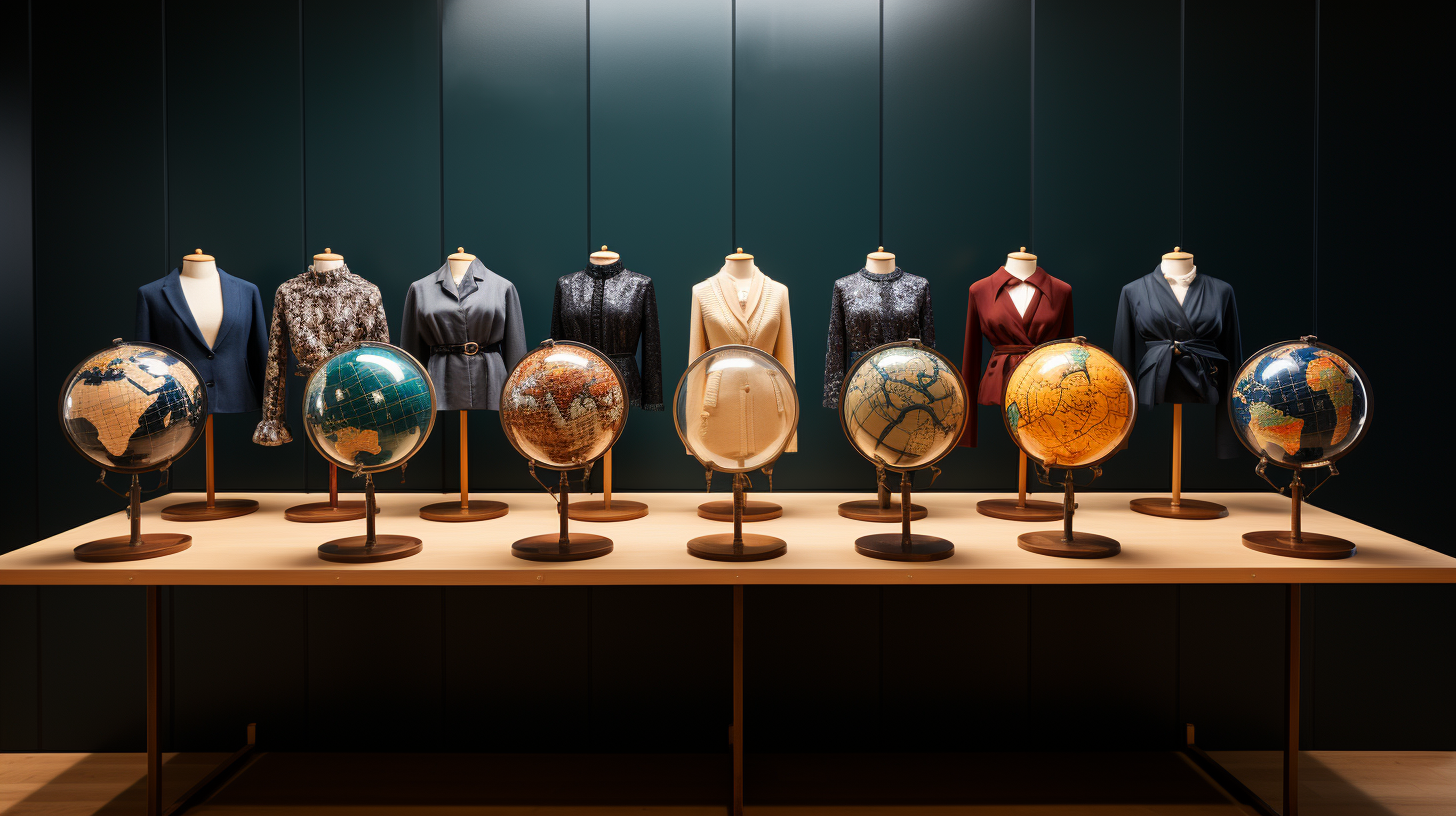
The Lasting Impression: 1940s Men’s Suits Through the Lens of Time
In the tapestry of menswear, the Enduring Legacy of 1940s Men’s Suits stands as a towering testament to an era’s ingenuity. The ’40s were not just years marked by global upheaval but also by the indomitable resolve to maintain elegance and style against the odds. Those sharp silhouettes were more than mere fashion—they were a morale booster, a badge of honor, and a beacon of hope during turbulent times.
Reflecting on The 1940s as a Reflection of Resilience and Innovation, we’re not just talking about clothes here. We’re talking about the fabric of society itself—how a world at war clung to the sophistication of the suit as a symbol of life moving forward. The craftsmanship of the time was not merely a trade; it was a form of quiet rebellion against the chaos of war, a stitch in time to mend the worn spirits of society.
As we look at Modern Interpretations and Inspirations, it’s clear that the style mavens of today still tip their fedoras to the forties. Designers continue to draw upon the structured elegance of the era, proving that true style is indeed timeless. It’s evident in the sharp tailoring of contemporary suits, the nostalgia-laden collections on fashion runways, and the vintage pieces that continue to be treasured and worn with pride.
In our Closing Thoughts: The Timeless Appeal of the 1940s Silhouette, it’s undeniable that the suits of the 1940s have a staying power that transcends mere nostalgia. They embody a historical narrative, a chapter of craftsmanship, and a period of creativity born from necessity. The suits of the 1940s have etched a permanent crease in the pages of fashion history, reminding us that even in the face of adversity, style remains an unassailable bastion of cultural identity.
And with that, we tie up our series on the Sharp Silhouettes of 1940s Men’s Suits. This conclusion draws our sartorial journey to a close, having woven through the intricate details, the cultural significance, and the lasting impact of 1940s menswear.


